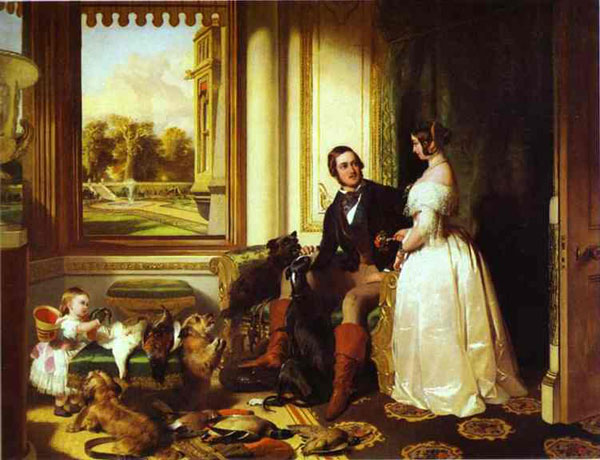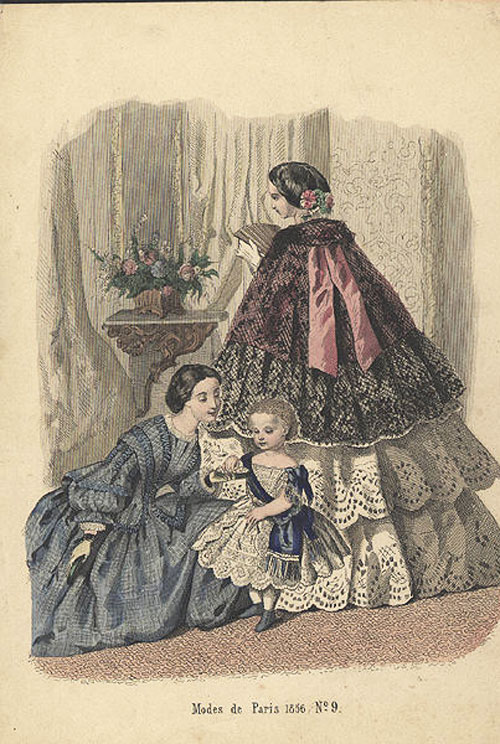 Windsor Castle in Modern Times by Landseer depicts the Queen and the Prince Consort "at home" in the 1840s.
Windsor Castle in Modern Times by Landseer depicts the Queen and the Prince Consort "at home" in the 1840s. The term "Victorian fashion" refers to fashion in clothing in the Victorian era, or the reign of Queen Victoria (1837–1901). It is strictly used only with regard to the United Kingdom and its colonies, but is often used loosely to refer to Western fashions of the period. It may also refer to a supposedly unified style in clothing, home décor, manners, and morals, or a culture, said to be prevalent in the West during this period.The broad silhouette of the 1830s was replaced with a triangular line with vertical emphasis. Shoulders became narrow and sloping, waists became low and pointed, and sleeve detail migrated from the elbow to the wrists. Where pleated fabric panels had wrapped the bust and shoulders in the previous decade, they now formed a triangle from the shoulder to the waist of day dresses.Skirts evolved from a conical shape to a bell shape, aided by a new method of attaching the skirts to the bodice using organ or cartridge pleats which cause the skirt to spring out from the waist. Full skirts were achieved mainly through layers of petticoats. The increasing weight and inconvenience of the layers of starched petticoats would lead to the development of the crinoline of the second half of the 1850s.
The term "Victorian fashion" refers to fashion in clothing in the Victorian era, or the reign of Queen Victoria (1837–1901). It is strictly used only with regard to the United Kingdom and its colonies, but is often used loosely to refer to Western fashions of the period. It may also refer to a supposedly unified style in clothing, home décor, manners, and morals, or a culture, said to be prevalent in the West during this period.The broad silhouette of the 1830s was replaced with a triangular line with vertical emphasis. Shoulders became narrow and sloping, waists became low and pointed, and sleeve detail migrated from the elbow to the wrists. Where pleated fabric panels had wrapped the bust and shoulders in the previous decade, they now formed a triangle from the shoulder to the waist of day dresses.Skirts evolved from a conical shape to a bell shape, aided by a new method of attaching the skirts to the bodice using organ or cartridge pleats which cause the skirt to spring out from the waist. Full skirts were achieved mainly through layers of petticoats. The increasing weight and inconvenience of the layers of starched petticoats would lead to the development of the crinoline of the second half of the 1850s.Sleeves were narrower and fullness dropped from just below the shoulder at the beginning of the decade to the lower arm, leading toward the flared pago
 da sleeves of the 1850s and 1860s.
da sleeves of the 1850s and 1860s.Evening gowns were worn off the shoulder and featured wide flounces that reached to the elbow, often of lace. They were worn with sheer shawls an opera-length gloves.
Another accessory was a small bag. At home bags were often white satin and embroidered or painted. Outdoor bags were often green or white and tasseled.
The introduction of the steel cage crinoline in 1856 provided a means for expanding the skirt still further, and flounces gradually disappeared in favor of a skirt lying more smoothly over the petticoat and hoops. Pantalettes were essential under this new fashion for modesty's sake.
By the early 1860s, skirts had reached their ultimate width. After about 1862 the silhouette of the crinoline changed and rather than being bell-shaped it was now flatter at the front and projected out more behind.
Day dresses featured wide pagoda sleeves worn over undersleeves or engageantes. High necklines with lace or tatted collars or chemisettes completed the demure daytime look.
Evening dresses had low necklines and short sleeves, and were worn with short gloves or lace or crocheted fingerless mitts. Large crinolines were probably reserved for balls, weddings and other special occasions.
Princesse Albert de Broglie - 1853
 unwanted bulk at the waist; this spelled the end of the brief fashion for border-printed dress fabrics.
unwanted bulk at the waist; this spelled the end of the brief fashion for border-printed dress fabrics.Heavy silks in solid colors became fashionable for both day and evening wear, and a skirt might be made with two bodices, one long-sleeved and high necked for afternoon wear and one short-sleeved and low-necked for evening.
As the decade progressed, sleeves narrowed, and the circular hoops of the 1850s decreased in size at the front and sides and increased at the back. Looped up overskirts revealed matching or contrasting underskirts, a look that would reach its ultimate expression the next two decades with the rise of the bustle. Waistlines rose briefly at the end of the decade.
Fashions were adopted more slowly in America than in Europe. It was not uncommon for fashion plates to appear in American women's magazines a year or more after they appeared in Paris or London.
Michelle
thnx to: Wikipedia and University of Washington



Can you describe what a organ or cartridge pleat is like? Can it be adapted to mini doll ladies. I'm looking for a way to have the full skirt gathered that still leaves the waist looking small.
ReplyDeleteBrad
ps. this is a great article. I'm often unsure of clothing time periods. Looking at the design themes you point out is a huge help and much appreciated.